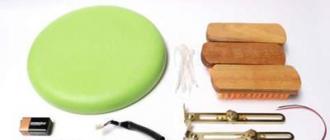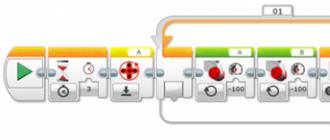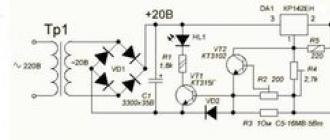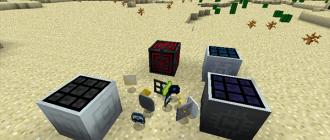You have probably read on different sites advice like: "Type such and such a line on the command line and you will be happy." But you don’t know how to get into the command line and what it is.
The shell is a separate program that provides communication between the user and the OS. It looks like a normal window with a black screen and a blinking cursor. It is here that the commands that the user enters are written and executed. Interface command shell called the console.
In this article, let's take a look at 5 ways with which you can run the command line in various operating systems Windows: XP, 7, 8 and 10.
1 way: through Start
Let's start with Windows 7. Click on the Start button at the bottom left, and then click "All Programs". Expand the folder and click on the item we need. It is located between the Calculator and Scissors. But it may not always be in the list, for example, it is not in the example.

If you are using Windows 10, then also click Start, expand the folder and select the appropriate item there.

Method 2: Use Search
Press Start again and type in the empty line at the bottom "cmd". In the results, select the name of the same name.

In the top ten, the search is opened with hot keys "Win + Q". Then enter "cmd" and click on the item that appears as a result.

For those who have Windows 8: as described above, using "Win + Q", go to the search and open the command line through it.

3 way: through the Run window
To open it, use the keys "Win + R". Next, in the line "Open" write "cmd" and click "OK". If you often go to the console, then use this way convenient enough - what you were looking for is remembered, and in the future you just need to press "OK".

If you need to run it as an administrator, then in 8-ke and 10-ke you can use the context menu. Press either the right mouse button on the Start button, or use the hot combination "Win + X". All the necessary items will be here, and, and « Command line» , it will also open with administrator rights.

In the eight, I don’t have a Start, but using hot keys, display desired list pretty simple.

Also here you can use the tiles on the start screen, which appears after pressing the button "Win". Click right click click on the tile with the desired name and at the bottom you can select either run as administrator, or you can pin it to the taskbar if you use it often. Double clicking on a tile will simply launch the program.

Method 4: opening the context menu
Select the desired folder, file, drive, or even an empty space on the desktop, hold "Shift" and right-click on the selected one. In the list that opens, select "Open command window".
This method is convenient in that the work will start immediately from the file, folder or any other that you have selected.

For example, I chose the Downloads folder, and it was from there that the command line began to work.

Method 5: open the system folder
Go to the "Computer" folder and follow the path: C: WindowsSystem32. There will be the "cmd" we need, note that it says "Application" opposite it in the "Type" column.

If you have Windows XP, then you can call the command line in several ways.
1. Click « Start - Run» and in the window that opens, write cmd.

Press " OK” and get into the console:

2. You can also call the command line by pressing « Start - Programs - Accessories - Command Prompt» .

There are plenty of ways to call the command line in Windows XP, 7, 8 or 10. Choose any of them and your task will be solved.
Watch a video on the topic:
Rate article:
(1
ratings, average: 5,00
out of 5)
Webmaster. Higher education in the specialty "Information Protection". Author of most articles and computer literacy lessons
- press the "Windows" key it has a Windows icon and at the same time the Rquot ; key. Next, write cmd and press Enterquot ;.
- go to the Startquot ; menu, then in it Programsquot ;, then select Standard and already there select the item Command linequot ;.
In order to call the command line in operating systems such as Windows 7 / Vista / 8 or in the good old Windows XP, you can use the Win + R key combination, where Win is the key on which the Windows logo is displayed. After pressing the keys, a window will appear in which you need to enter the command cmd in English and press okquot ;. The black window on the screen with white text and a blinking cursor that will appear on the screen is our command line, in which special commands are written to control the computer.
To call the command line, you can use the win + r hot keys, and you can also do it as follows. Click the Start menu, then Programs, Accessories tab, then Command Prompt, and hit enter.
The fastest and most practical way to call up the command line in Visible and set some command is to press and hold the Win (with a picture of window) and press Rquot ;. In the field provided, write cmd and confirm Enterquot ;. This is Sun.
Most fast way calling the command line - this is undoubtedly (located on the right at the very bottom). After clicking on Start, select Programsquot ;, then Standard and Command linequot ;, that is, the Console is in front of you!
Often, in different manuals and fakes they write about the fact that you need to call the command line. But - how to do it and what it is - is not written 🙂
What is command line?
The command line provides communication between the OS and the user. In Windows OS, everything is done with the mouse, i.e. - visually. Programs are loaded with a click, folders and files are created with a click. The same can be done on the command line, but with a set of special commands. When there was no Windows yet, it was on the command line that all work with the computer was carried out. In other words, the command line is the remnant of the DOS system and is used in most cases to debug a Windows system.
This is how the window looks like:

Now let's look at several options / ways to call this window.
Both in Windows XP and in versions of Windows 7 and Windows 8, the path to the command line is the same.
- By clicking on Start, you should have a button Run. By clicking on no, a window will appear Starting the programquot ;. In the field open You write three letters - cmd- confirm with the button OK and get a window with the console. (If the Run button is not availablequot ;, then you need to enable it in the settings, namely: Start / Properties / Advanced / (or right-click on Start and Properties) - find and check the box - Run .
- More quick call window Run, you get by pressing hotkeys: Windows button(with windows, usually located between STRG and ALT) + letter key R. Then type - cmd - and confirm with the OK button.
- You can also call the command line console through the menu by clicking on Start/Programs/Accessories/Command Prompt
- Well the longest: By opening the partition on which Windows is located, entering the folder Windows/System32 and double clicking on the file cmd.exe
- First you need to go to the tiles with applications (new version of Start) and right-click on a free area. As a result, a panel will pop up at the bottom, giving advanced features.
In it, you need to click on the icon All applications in the lower right corner. - Here you will see a list with additional hidden applications, including the Command Prompt shortcut. Now you need to click on the desired shortcut with the right mouse button and select the option to run as administrator in the bottom panel.
You can call the command line (console) in Windows 8 (7, XP) in the following ways:
The command line is the means through which we access control of our operating system and do so by entering various commands.
And in order to open the command line in Windows 8 (7, XP), you should perform a certain action.
The easiest first way to call it is by pressing key combinations Win+R, then confirming the action through Enter and opening the service - Runquot ;.

How else to call the command line we need in Windows XP and Windows 7, you need to click on the "Start" menu, then click on the command called "Run", and then in the window that opens you need to write-cmd and click-quot ;OK.
Sometimes it becomes just necessary to call the command line. This is required to perform any actions in Windows using certain commands. We press the button START then choose EXECUTE then we write the command cmd and confirm your actions by pressing OK.
from the menu: start - accessories - command line ...
Keyboard shortcut: Win + R, type cmdquot ;, press Enter.
Learn to use the mouse to a minimum, the keyboard is faster.
For the correct command line invocation in operating Windows systems XP, 7 and 8, you need to hold down the quot key on the keyboard; Windows in the form of windows and R English - a line will appear - enter it in English cmd and press Enter - then enter the desired command.
There are many ways to call the command line. Recently, I had to open e when the computer did not want to turn on, and so, I had to throw the installation on the USB flash drive and run the line through the installation window. And if you don’t have such problems, then you can use the combination Win + Rquot ;, then cmd and Enter.
More than one generation of those Internet users has already grown up who did not catch the beginning of the rapid rise of Microsoft Corporation and do not even know how to open the command line.
This early version of the Windows operating system, called MS DOS, featured single-tasking (all processes ran sequentially, not in parallel) and a predominantly text-based interface.
Now most of the operations on the computer under Windows control can be done exclusively with the mouse, and in those days even for the most simple actions it was necessary to know a lot of complex text commands.
Through a shortcut in the start menu
Running the Run program to open a command prompt is a strange idea, since the required shortcut is right next door.

It can also be quickly found through the Start menu search.

Due to a significant change in the Start menu interface in Windows 8, this method will be implemented slightly differently.


Advice! Running with administrator rights is recommended because some commands simply will not run normally.
In Windows 10, search works throughout the system. Therefore, to quickly find the command line, you need to press the combination Win + S and enter the name of the program, in this case it is the command line.

Search for an executable file on the system drive
As mentioned above, the command line is implemented through a small executable cmd.exe file.
From here we can make a logical conclusion that this executable can be found in some folder and run directly.
This is true, the command line executable starting from the seven is stored in the System32 subdirectory Windows folder.


No. 9. Command line file in Windows search 10
Visitors to our site have repeatedly asked us questions regarding such a tool as " command Windows string "she is" cmd", the essence of which boils down to their poor understanding of the Windows command line and its need in general. What is the command line, how to run command prompt and what commands can be entered into it - we will try to give answers to these questions in the near future.
Since this topic is quite extensive, we will talk about everything in order. In this article, for starters, we will tell you how to open the Windows command line in different versions operating systems - XP, 7 or 8. We already talked about that in a separate article.
In fact, there are several ways to enable the Windows command line in each version of the operating system. There are both common, working in all versions of the OS, and present only in one or another Windows versions, for example in the "finger-oriented" 10-ke. There is no point in listing all of them, it is enough to talk about the simplest and most convenient way for each operating system.
In order to launch the command line in the Windows XP operating system, open the menu "Start", find the bottom right line "All programs" and open the menu item "Standard". In the list that opens, find the line with the name "Command line" and click on it.
As a result, you will see the Windows XP Command Prompt window that opens.

The process of opening the cmd prompt in Windows 7 is similar to that in XP. Open panel "Start", select an item "All programs", in the menu that opens, find the folder "Standard" and in it click on the executable file with the name "Command line".

How to Open Command Prompt in Windows 8 and 8.1
To open the command line in the Windows 8 or 8.1 operating system with a "tiled" interface, the procedure is different from those in XP and 7. Open the menu "Start" with tiles and right click in an empty area. An additional panel with an icon will open at the bottom. "All Applications". Click it. In the application window that opens, you just have to find a shortcut with the name "Command line" and run it.

Launching the command line through the "Run" program
You can also enable the command line in any of the above versions of the Windows operating system using the program. To do this, press the keyboard shortcut Win+R on keyboard.

Then in the window that opens "Run" enter the command cmd and press "OK". The Windows Command Prompt will open.

The command line is a unique tool that, despite its similarity to what many people think is an outdated interface similar to the previously used DOS mode, has quite a wide range of features that can be accessed in the usual GUI Windows turns out to be impossible. And you can launch it in several ways. But calling the command line with hotkeys, despite the protests of some users who are accustomed to using the mouse exclusively, is much more convenient and faster. How to do this, we will discuss further. And to begin with, let's briefly dwell on why you need to use the console itself and its tools.
What is the command line for?
So, most often the command console is usually used to fix failures in the operating system, check some of its components, perform operations on disks and partitions, enable and disable some Windows features, standard procedures for copying, deleting objects (if login is not possible), etc. Of course, this tool loses somewhat to the PowerShell console, which, in addition to standard features command line, has an extended set of tools (for example, it allows you to remove "wired" in Windows programs). Nevertheless, it is much easier to use, it will not be difficult to deal with the basic commands and operations, especially since it has a short reference system with examples.
How to call the command line in Windows 7 and above in the simplest way?
Now directly about the launch. Immediately note that starting the console itself in operating Windows systems the seventh modification and above can be done in two ways: with a normal start and run as administrator. At the same time, even disabling the built-in registration record of the so-called super administrator does not apply to starting the command line. That is why some applets and commands run incorrectly or cannot be executed at all.
In the simplest and fastest version, the launch is made from the "Run" menu, which is called quick combination Win + R, after which the cmd combination is entered in the start line of the program and the enter key is pressed. But where is the "Win" key on the keyboard? As a rule, on standard models it is located on the left between the Ctrl and Alt buttons (or between Alt and Fn). On some that are used in laptops or tablets with small screen diagonals, the desired key may be located on the right side to the left of the arrow buttons.
Where is the "Win" key on the keyboard, figured it out. But how else can it be used? In any system, with its help, you can call the start menu itself (this corresponds to pressing the "Start" button, and only then go to the desired section. But how to call the command line in "Windows 7" or in any other system from here?

To do this, you need to move to the section utility programs(the arrow buttons are used to navigate, the "Enter" is used to enter the submenu and launch the applet itself).
How to launch command prompt with keys as administrator?
As it is already clear, above it was only about the usual start of the console, in which administrator privileges were not taken into account. But sometimes they are essential. If we are talking about Windows 7, after calling the runtime console, the box for running the command line applet as administrator must be checked. You can move to the desired item using the tabulator (Tab), and set the selection by pressing the spacebar. After that, it remains to confirm the launch with the enter key (it is completely optional to move to the "OK" button.
To exit the console, you can use either the exit command or the standard close active window using the combination Alt + F4.
Launching the console directly from a file
You can also start the console directly from a file located in the System32 directory of the system root folder. In this case, the actions are somewhat more complicated, since it will be impossible to directly call the command line with hot keys, but you will have to use the standard file manager. To call the "Explorer", the Win + E combination is used, after which the arrows navigate through the folders, enter them and open files by pressing enter. Yes, but if we are talking about calling the command line with hot keys on behalf of the administrator, this technique is not applicable. It's good if the keyboard itself has a special context menu button (usually located to the right, either between the Alt and Ctrl buttons, or to the right of the spacebar.

But for those keyboard models that do not have such a button, you can use the combination Shift + F10 (using Ctrl + Shift + F10 opens an extended context menu).
The nuances of launching the console in Windows 10
In the eighth and tenth versions of the system, in the program launch console, the item to start the executable command on behalf of the administrator may be absent. In this case, you can use the technique described above, but the easiest way is to use hot keys to access the command line in another way.

From the “Run” menu, the taskmgr command first launches the “Task Manager”, the Alt button activates the file menu, the down arrow selects the new task launch item, after which a window appears that repeats the “run” console, but with the task start item with administrator rights.
To access the Task Manager, you can also use shortcuts like Del + Alt + Ctrl or Esc + Shift + Ctrl, which is much easier. Context menu The start button is called by a quick press of Win + X, and there is already a command console start point both in normal mode and with administrator rights.
Using keyboard shortcuts at system startup
In Windows 7 and earlier systems, there is also a keyboard shortcut for calling the command line. At the very beginning of the download, you can call an additional start menu. To do this, use the F8 key (sometimes Alt + F8 or something similar).

After that, simply select the boot item with command line support.
Note: to return the use of F8 in the eighth and tenth modifications of Windows, in the command console launched with administrator rights, run the command "bcdedit / set (current) bootmenupolicy legacy" (without quotes at the beginning and at the end).
Console start when booting from removable media
To run command line hot windows keys when starting from removable media, for example, from any boot, installation or recovery disk, they are used in a single combination - Shift + F10 (and for all versions of the system, and for all types software present on disks).

Note: to exit the console when you are finished working with it, it is best to use the exit command, after which you can go to other menu items by navigating through them using additional keys, as described in the examples above.






